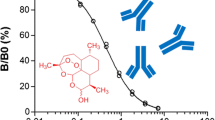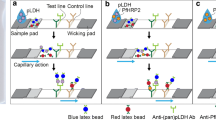Abstract
Artesunate is a frontline antimalarial drug for treating Plasmodium falciparum malaria. To produce specific antibodies to artesunate, the carboxyl group of artesunate was directly conjugated to carrier protein as the immunogen. A specific monoclonal antibody (mAb) 3D82G6 against artesunate was obtained by high-throughput screening of positive hybridoma clones. This monoclonal antibody had 4.0, 0.5, and 0.9 % cross reactivities with artemisinin, dihydroartemisinin, and artemether, respectively. A dipstick immunoassay was developed, and the indicator range for artesunate was 1000–2000 ng mL−1. No interference was observed with artemisinin, dihydroartemisinin, artemether, and other commonly used antimalarial drugs for up to 20,000 ng mL−1. The dipsticks were used for determination of artesunate contents in commercial drugs, and the results were agreeable with those determined by high-performance liquid chromatography. This dipstick, with its specificity and sensitivity for artesunate and simplicity to use, makes it a potential point-of-care device for rapid quality evaluation of artesunate-containing antimalarial drugs.

Specific monoclonal antibody-based lateral flow dipstick for artesunate





Similar content being viewed by others
References
World Health Organization. World Malaria Report 2014. 2014. Avarilable: http://www.who.int/malaria/publications/world_malaria_report_2014/en/. Accessed 24 June 2015.
Kremsner PG, Krishna S. Antimalarial combinations. Lancet. 2004;364:285–94.
Newton PN, Fernández FM, Aline PO, Mildenhall DC, Green MD, Li Z, et al. A collaborative epidemiological investigation into the criminal fake artesunate trade in South East Asia. PLoS Med. 2008;5:e32.
Shunmay Y, Harriet LSL, Patricia T, Chea N, Albert VW, Naiela M, et al. Quality of antimalarials at the epicenter of antimalarial drug resistance: results from an overt and mystery client survey in Cambodia. Am J Trop Med Hyg. 2015;92:39–50.
Goodman C, Kaur H, Wyk AV, Malik N, Lynch C, Fadeyi I, et al. Quality of artemisinin-containing antimalarials in Tanzania’s private sector—results from a nationally representative outlet survey. Am J Trop Med Hyg. 2015;92:75–86.
Batty KT, Davis TM, Thu LT, Binh TQ, Anh TK, Ilett KF. Selective high-performance liquid chromatographic determination of artesunate and alpha- and beta-dihydroartemisinin in patients with falciparum malaria. J Chromatogr B. 1996;677:345–50.
Green MD, Mount DL, Wirtz RA, White NJ. A colorimetric field method to assess the authenticity of drugs sold as the antimalarial artesunate. J Pharmaceut Biomed. 2000;24:65–70.
Global Health Pharma Fund. The GPHF-Minilab™-Protection Against Counterfeit Medicine. 2015. Available at: http://www.gphf.org/web/en/minilab. Accessed 8 November, 2015.
Jähnke RWO, Küsters G, Fleischer K. Low-cost quality assurance of medicines using the GPHF-Minilab®. Ther Innov Regul Sci. 2001;35:941–5.
Song ZY, Zhao KC, Liang XT, Liu CX, Ming Guang YI. Radioimmunoassay of qinghaosu and artesunate. Acta Pharm Sinica. 1985;20:610–4.
Tanaka H, Putalun W, De-Eknamkul W, Matangkasombut O, Shoyama Y. Preparation of a novel monoclonal antibody against the antimalarial drugs, artemisinin and artesunate. Planta Med. 2007;73:1127–32.
Eggelte T, Van AMT, Van BC. The development of an immunoassay for the detection of artemisinin compounds in urine. Am J Trop Med Hyg. 1999;61:449–56.
He SP, Tan GY, Li G, Tan WM, Nan TG, Wang BM, et al. Development of a sensitive monoclonalantibody-based enzyme-linked immunosorbent assay for the antimalaria active ingredient artemisinin in the Chinese herb Artemisia annua L. Anal Bioanal Chem. 2009;393:1297–303.
He LS, Nan TG, Cui YL, Guo SQ, Zhang W, Zhang R, et al. Development of a colloidal gold-based lateral flow dipstick immunoassay for rapid qualitative and semi-quantitative analysis of artesunate and dihydroartemisinin. Malar J. 2014;13:185–92.
Zhao J, Li G, Wang BM, Liu W, Nan TG, Zhai ZX, et al. Development of a monoclonal antibody-based enzyme-linked immunosorbent assay for the analysis of glycyrrhizic acid. Anal Bioanal Chem. 2006;386:1735–40.
Frens G. Controlled nucleation for the regulation of the particle size in monodisperse gold suspensions. Nature. 1973;241:20–2.
Guo SQ, Cui YL, He LS, Zhang L, Cao Z, Zhang W, et al. Development of a specific monoclonal antibody-based ELISA to measure the artemether content of antimalarial drugs. PLoS One. 2013;8:e79154.
Acknowledgments
This research was supported by National Institute of Allergy and Infectious Diseases, National Institutes of Health (U19AI089672).
Author information
Authors and Affiliations
Corresponding authors
Ethics declarations
Animal treatment
The authors declare that they have no competing interests.
Ethical standards
Female Balb/c mice were purchased from the Laboratory Animal Center of the Institute of Genetics (Beijing, China). This study was performed strictly according to the standards described in the “Guide for the Care and Use of Laboratory Animals” (National Research Council Commission on Life Sciences, 1996 edition). All animal treatment procedures were approved by the Animal Care Committee of China Agricultural University (CAU), and all efforts were made to minimize suffering. Mice were housed under controlled temperature (22 ± 2 °C) and lighting (12 h light/12 h darkness) with food and water ad libitum in air-conditioned rooms. All experimental mice were killed by cervical dislocation.
Additional information
Published in the topical collection Immunoanalysis for Environmental Monitoring and Human Health with guest editors Shirley J. Gee, Ivan R. Kennedy, Alice Lee, Hideo Ohkawa, Tippawan Prapamontol, and Ting Xu.
Rights and permissions
About this article
Cite this article
Guo, S., Zhang, W., He, L. et al. Rapid evaluation of artesunate quality with a specific monoclonal antibody-based lateral flow dipstick. Anal Bioanal Chem 408, 6003–6008 (2016). https://doi.org/10.1007/s00216-016-9363-9
Received:
Revised:
Accepted:
Published:
Issue Date:
DOI: https://doi.org/10.1007/s00216-016-9363-9




